“EXPOSED… Decline in habitat leaves grouse open, vulnerable”
By Dick Ellis
Reader Note: The following Dick’s Trip column to Richland County was taken in the new year of 2006 to study grouse mortality with a UW-Richland Center Assistant Professor of Biology.
A broken but steady mortality signal carried more bad news over the steep bluff and valley country of Richland County to Scott Walter’s hand held radio-receiver. “That grouse is dead,” said the Assistant Professor of Biology at UW-Richland Center. “We can hope he’s snow roosting. But we’d be receiving a faster signal if he moved at all. He’s a long way from where he has been in the thick cover of the reverted apple orchard.”
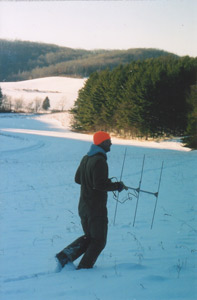 |
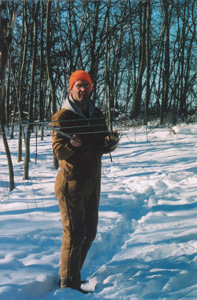 |
| “Assistant Professor of Biology Scott Walter of UW-Richland Center follows the radio transmitter in the growing shadows of afternoon toward another grouse killed by a predator. Walter believes a loss of habitat has led to a ruffed grouse population decline of up to 90 percent in the region in just two decades.” | “Assistant Professor of Biology Scott Walter of UW-Richland Center follows the radio transmitter in the growing shadows of afternoon toward another grouse killed by a predator. Walter believes a loss of habitat has led to a ruffed grouse population decline of up to 90 percent in the region in just two decades.” |
Walker is concluding a three year study for the University with a probable extension of one year that is investigating the severe decline of the ruffed grouse in southwest Wisconsin since the mid-1980s. Funded by The Ruffed Grouse Society and the KickapooValley Reforestation Grant program with DNR manpower and equipment and the work of university students Jessica Haucky and Jerrimy Gudgeon, the project has been capturing and via radio telemetry tracking grouse in Richland County. Walter believes the project provides reasons for the stark reality that ruffed grouse numbers have declined up to 90 percent in Wisconsin’s southwest in just two decades.
“The hey-day for the ruffed grouse in the southwest was the sixties, seventies and into the eighties,” Walter said. “It was recognized as a great grouse area. Drum surveys compare southwest Wisconsin with northern Wisconsin. The north has a predictable population cycle. The southwest never cycled, yet it consistently had as many or more grouse as northern Wisconsin had in its peak years. And just think about the excitement that the north generates in its peak years.”
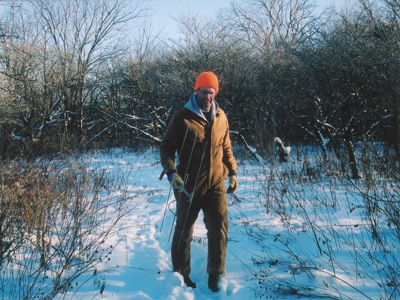
Assistant Professor of Biology Scott Walter at UW-Richland Center follows a radio mortality signal from ideal grouse habitat.
Although professionally trained to conduct research, the severe decline in grouse numbers is also personally frustrating to Walter. As current owner of a 140 acre Richland County farm that has been family held for seven generations, he remembers the 100-flush days grouse hunting with friends, and a box of spent shells by day’s end.
“I experienced it. I miss seeing the grouse,” he said. “In the early to mid-80s numbers started to slide. Today maybe we won’t see one flush. The hey-day is gone.” Three theories he said, have risen to explain the decline of grouse numbers; the introduction of the wild turkey to Wisconsin, habitat changes, and predation. The loss of ideal grouse habitat, he is certain, caused the decline. Predators ultimately make the kills or devastate the nests, but it is the loss of thick cover that makes the birds vulnerable.
“A lot of people saw the decline of the grouse with the increase of turkey numbers in Wisconsin and drew a cause and effect conclusion,” he said. “But the grouse and turkey are adapted for different types of habitat. There’s no competition. Functionally the theory has no merit.”
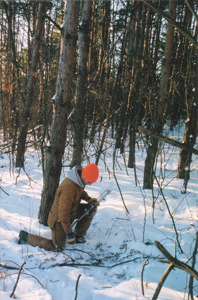
The radio mortality signal leads Scott Walter, Assistant Professor of Biology at UW-Richland Center to the feathered remains of another grouse.
“Some people say its predation but that’s a little too simplistic. It’s always predation when you’re talking about ruffed grouse dynamics. Anyone who ever hunted grouse knows that you find them in the thickest, nastiest cover that provides protection from predators. I’m concerned now not with restoring grouse numbers, but with stimulating interest in habitat management. The key to impacting the grouse population is instilling a broader appreciation of the role of forest management as a means to improve wildlife habitat.”
Historically, Walters said, southwest Wisconsin’s flat country was almost entirely agricultural in the early 1900s. Any acreage too steep for crops was used as pasture, with those hillsides predominantly open with scattered, large trees. A big change occurred, he said, when small family farms disappeared.
“Even where farms did exist you didn’t see those wooded pastures,” Walter said. “Cows are kept in feedlots. Good grouse habitat, brush like prickly ash, sumac, and multiflora rose sprang up on the hillsides in the forties, fifties and sixties and beyond. That is when the hey-day occurred for grouse and that is what people remember.”
Without some consistent natural or man-made disturbance on the hillsides from, for example, livestock, fire, or extensive timber harvest, the forest and ideal grouse habitat changed over time. Walter said “later successional forest species” began to dominate and the forest evolved to more of an “open turkey woods.”
“There is less areas ideal for grouse,” he said. “The change left small patches of brush on field edges, little strips near fence lines and quarter-acre pockets instead of vast expanse. Thirty years ago that expansive area allowed extra birds to move out to other areas. When you think about grouse nesting needs and young grouse dispersing across open forest that is very dangerous. Sub-optimal grouse cover makes them more prone to predators.”
In 2003, with a catch-22 problem of attempting to capture grouse to study the population decline where few grouse now exist, Walter initiated the radio telemetry project from UW-Richland Center. Utilizing 50 to 100 foot long sections of two-foot high drift fencing that led to a box trap with funnel entrance, 46 grouse were captured.
To examine population dynamics, Walter said, researchers hope to follow the female species. However, only 18 grouse of the 46 captured were female due to a higher mortality rate for the female and a population then skewed toward the male.
“The preliminary survival analysis indicates that the females survive much less than the males,” he said.
“We caught two males for every female in the traps. In late winter and early spring the mortality rate for females increased significantly. I think the females begin to look for nesting areas in March and the mortality increase coincides with greater movement away from thick cover.”
Of the birds captured, only five females survived to spring of 2004/2005. Of those one female did not nest after her nest was destroyed and one left no evidence of having built any nest. One female was killed on the nest probably by a skunk several days before her hatch. Two females hatched their nests with broods of 11 and 12 chicks. Both females were killed within two weeks of the hatch, rendering the likelihood of any member of the clutches surviving predators and the cold virtually non-existent.
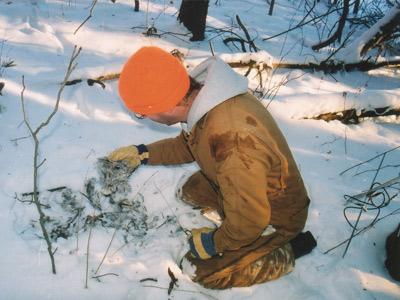 |
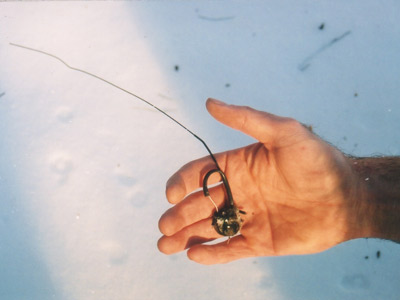 |
| “In an open red pine stand, the radio mortality signal leads Scott Walter, Assistant Professor of Biology at UW-Richland Center to the feathered remains of another grouse. Searching for food with protection of thick habitat, he bird was killed by an avian predator.” | “The radio necklace and feathered remains provides the evidence of another ruffed grouse killed by a predator in Richland County. Loss of habitat has led to a decline of ruffed grouse in the region in just two decades, according to an ongoing study at UW-Richland Center.” |
“Each hen took their broods into very thick cover for insects which the chicks need,” Walter said. “Both were in mature forest without dense forest cover or cut-over area with thick black berries. To get the insects they had to move their broods into areas without cover from predators.”
An abundance of early successional habitat so prevalent in the region decades ago, Walter said, is imperative to the survival of the ruffed grouse. Early successional habitat though, defined as high stemmed brush without an overhead tree canopy, is severely lacking. Of 22 different forest types in western Wisconsin, one is early successional, which makes up seven percent of the region’s total forest cover. 83 percent of the radio collared grouse, though, chose early successional habitat as residence.
“If ruffed grouse are an early successional forest bird, then only seven percent of forest cover is good grouse habitat,” Walter said. “Look at the location of the radio birds. That is where they are. I suspect if we have more of that cover we will have more grouse.”
Less of that cover, though, too often means death by predation. December 19, Walter followed the radio signal from the ideal habitat of an overgrown apple orchard high on a ridge approximately one-quarter mile to an open stand of red pine. There all hope of a snow roosted grouse was lost with the uncovering in the snow of feathered grouse remains, the radio transmitter and evidence of an avian kill. With it came more evidence that a lack of habitat cost another grouse its life.
“This is an adult male grouse that had been spending all of the early winter in the thick cover of the apple orchard,” Walter said. “He moved out of that cover a quarter-mile looking for food where he was left exposed in the open pines and killed. Loss and fragmentation of habitat as the forest matures leaves the birds vulnerable to predation.”
The time is now, Walter said, for a greater understanding among landowners regarding how forest management on their individual properties can work collectively with their neighbors to benefit a variety of wildlife. Early successional cover will not only benefit grouse but other bird species also in decline that require brushy habitat. As but one example, the forest interior dependent species Scarlet Tanager, a beautiful songbird, requires large blocks of intact forest and has been impacted by habitat fragmentation.
“Think about northern Wisconsin and the hundreds of thousands of acres of public land,” he said.
“Management is more set. Southern Wisconsin is made up of a patchwork quilt of private landowners with from five to 500 acres. To have an appreciable impact we need landowners that understand the system and work together to promote forest management across a broad scale.”
But the landowner of 40 acres, he said, with maple syrup or timber harvest or other individual interests may not hold wildlife management high on his priority list. Or, the property owner with four or five acres probably won’t be able to promote quality grouse habitat unless working in concert with his neighbors.
“We have to get away from the mentality that clear-cutting is inherently bad,” Walter said. “Clear cutting and other types of intensive forest harvest can have huge wildlife benefits if part of a forest management program. The time is now.”
Contact Scott Walter at swalter@uwc.edu.







